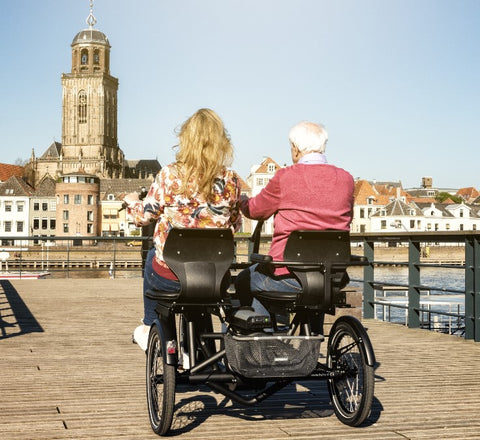Offer
Provide additional details about the offer you're running.

Vision impairment can come in many different forms. Cycling advice should be tailored to suit the visually impaired individual. The most important thing we can do as a business is provide options and choice to potential and current riders.
Many vision impaired riders have considered riding a linear tandem. If you have access to a skilled pilot, you can ride great distances and over challenging terrain. For others, they live with low vision which causes some vision constraints but not enough to prevent them from actively engaging in independent riding. For these riders, it is all about offering appropriate supports to suit their condition.
Our customers include those who have mastered piloted tandem riders on mechanical and electric tandems, but we also work with those who would prefer to be on a trailer or side-by-side. Others can ride a stabilized two-wheeler while others rely on an attendant to ensure they steer and brake appropriately. Whatever the restriction, we believe our vision impaired customers should have choice.
Common symptoms:
We have customers who are vision impaired and have access to experienced pilots who can assist with riding. One of the most popular models has been the Huka Orthros side-by-side trike, while small riders quite enjoy a tandem trailer trike system piloted by another. With the advent of ebikes, the piloting is easier and safer and the tricycle back end distributes the load so well that you hardly know you are pulling another person along.
Where guides need to be in attendance to help the rider, we have experience with both rear steer and side steering options. Many of our bike range can be fitted with these additions to enable the rider to safely ride in open space areas. There are pros and cons of both rear and side steering, so always best to describe your usual routes and we can help give advice on what may work for you all.
Case studies:
A.N. (TTT)
P.H (dual)
Bikes for independent riding
Depending on the level and type of vision impairment, some customers are able to ride a bike independently. To ensure the rider is safe and other open-space users are also safe, some modifications to standard two-wheel or three-wheel bikes can be recommended. This needs to be tailored to suit the individual.
Example:

Ezi-Step 2+2 | Versatile design for growth Folding electric bike Adult stabilisers

i-Tri 20" | Small format purpose built electric trike, very stable with great torque for use on hills
Modifications which can be fitted to a bike being
Piloted bike options - Assisted riding
Part of the fun of riding is being able to share the experience. If you have someone in your life who is able to ride with you, whether in front, behind or alongside, it is often easier to manage the challenges vision impairment may cause for the safe riding, steering, avoidance of obstacles and other open-space users. Having a pilot ride with you often means you can ride longer, further and experience more variety in your route. A pilot can safely navigate roads and shared pathways which are not as accessible to independent riders with vision impairment.
There are several options for piloted riding available. These are not exclusively used by people living with vision impairment but are certainly a fun way to get out and about.

Tandems, whether fixed or trailer in design, provide a linear piloted solution for riders. Some models have the pilot in front (tandem trailer trike or traditional electric tandem) while others have the pilot behind but slightly higher to be able to see over the front rider.
Side by side options are ideal for riders who use signing as a primary means of communication. They are wider and consideration needs to be taken as to options for suitable routes and paths.
Other riders may prefer the security of being accompanied by a carer or attendant. In these instances, the support person may be close enough to assist with steering, braking and motor control, but do not necessarily need to be riding as well. This can limit the application of the bike to walking pace only so the attendant can keep up with the rider.
Contact us to discuss your options & speak with our team of specialists!
Sources:
https://www.sciencedirect.com/science/article/pii/S1369847819305170
https://www.blindsportsaustralia.com.au/cycling-sport